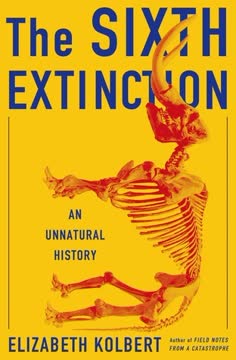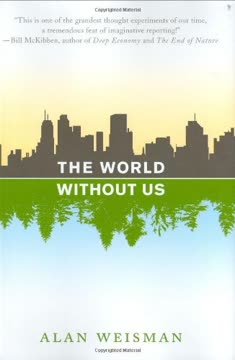Key Takeaways
1. Climate change is accelerating rapidly, with catastrophic consequences
It is worse, much worse, than you think. The slowness of climate change is a fairy tale, perhaps as pernicious as the one that says it isn't happening at all, and comes to us bundled with several others in an anthology of comforting delusions.
Rapid acceleration. The pace of climate change is far outstripping previous estimates. Since 1980, the planet has experienced a 50-fold increase in dangerous heat waves. The five warmest summers in Europe since 1500 have all occurred since 2002.
Catastrophic impacts. The consequences are already severe and worsening:
- Rising sea levels threatening coastal cities
- More frequent and intense extreme weather events
- Widespread drought and water scarcity
- Food insecurity and agricultural disruption
- Mass extinction of plant and animal species
- Spread of infectious diseases to new regions
Interconnected crises. Climate change acts as a threat multiplier, exacerbating existing environmental, social, and economic challenges. Its effects ripple through every aspect of human civilization and the natural world.
2. The impacts of global warming are far-reaching and interconnected
Climate change is fast, much faster than it seems we have the capacity to recognize and acknowledge; but it is also long, almost longer than we can truly imagine.
Cascading effects. Climate change triggers complex chains of environmental and societal impacts that compound and accelerate each other. For example:
- Melting Arctic ice reduces the planet's ability to reflect sunlight, accelerating warming
- Droughts and heat waves kill crops, leading to food shortages and price spikes
- Resource scarcity drives migration and conflict between populations
Global consequences. No region is immune to the effects of climate change:
- Extreme heat threatens habitability across the Middle East and tropics
- Sea level rise imperils coastal megacities from Miami to Shanghai
- Changing rainfall patterns disrupt agriculture worldwide
- Melting glaciers threaten water supplies for billions in Asia
Long-term impacts. The full consequences of our emissions today will play out over centuries and millennia, reshaping the planet's climate, geography, and ecosystems in ways difficult to fully comprehend.
3. Rising temperatures will make parts of the world uninhabitable
At seven degrees of warming, that would become impossible for portions of the planet's equatorial band, and especially the tropics, where humidity adds to the problem. And the effect would be fast: after a few hours, a human body would be cooked to death from both inside and out.
Deadly heat. As global temperatures rise, vast swaths of the tropics and equatorial regions will become too hot for human survival. Heat and humidity will combine to create conditions where the human body can no longer cool itself, leading to heat stroke and death.
Uninhabitable zones. Areas at risk of becoming uninhabitable include:
- Much of the Middle East and North Africa
- Parts of South Asia, including densely populated regions of India
- Portions of Southeast Asia, Central America, and northern South America
Cascading impacts. The threat of deadly heat will drive mass migration, economic disruption, and potential conflict as populations are forced to relocate. It will strain global food production and create new public health crises.
4. Food and water scarcity will intensify as the planet warms
Globally, grain accounts for about 40 percent of the human diet; when you add soybeans and corn, you get up to two-thirds of all human calories. Overall, the United Nations estimates that the planet will need nearly twice as much food in 2050 as it does today.
Agricultural disruption. Rising temperatures and changing rainfall patterns will dramatically impact global food production:
- Each degree of warming reduces grain yields by about 10%
- Key agricultural regions may become too hot or dry to support current crops
- Extreme weather events will increasingly damage or destroy harvests
Water crisis. Climate change is exacerbating existing water scarcity issues:
- Melting glaciers threaten water supplies for billions
- Droughts will become more frequent and severe in many regions
- Groundwater depletion is accelerating as demand increases
Global hunger. The combined effects on food and water supplies could lead to widespread malnutrition and famine, particularly in developing nations already struggling with food security.
5. Extreme weather events will become more frequent and severe
Each increase of a single degree Celsius in monthly temperature is associated with almost a percentage point rise of the suicide rate in the United States, and more than two percentage points in Mexico.
More disasters. Climate change is dramatically increasing the frequency and intensity of extreme weather events:
- Hurricanes and typhoons are becoming stronger and more destructive
- Heat waves are lasting longer and reaching higher temperatures
- Wildfires are burning larger areas and occurring in new regions
- Floods and droughts are becoming more severe and prolonged
Compounding impacts. These disasters often trigger cascading effects:
- Floods contaminate water supplies and spread disease
- Droughts lead to crop failures and food shortages
- Wildfires destroy homes and create air pollution crises
Human toll. Beyond the immediate destruction, extreme weather takes a heavy psychological toll, increasing rates of depression, anxiety, and even suicide in affected populations.
6. Sea level rise threatens coastal cities and island nations
By 2100, if we do not halt emissions, as much as 5 percent of the world's population will be flooded every single year.
Rising oceans. Melting ice sheets and thermal expansion of the oceans are causing sea levels to rise at an accelerating rate:
- Conservative estimates project 2-3 feet of rise by 2100
- More pessimistic scenarios suggest 6 feet or more is possible
Widespread flooding. Rising seas will inundate coastal areas worldwide:
- Many island nations may become uninhabitable
- Major coastal cities like Miami, New Orleans, and Shanghai face existential threats
- Millions will be displaced as low-lying areas are permanently flooded
Compounding threats. Sea level rise magnifies the danger of storm surges and tsunamis, making previously "safe" coastal areas newly vulnerable to catastrophic flooding.
7. Climate change will drive mass migration and conflict
By 2050, it is estimated that one in every seven people in Bangladesh is likely to be displaced by climate change.
Climate refugees. Environmental changes will force millions to leave their homes:
- Rising seas will displace coastal populations
- Drought and agricultural collapse will drive rural-to-urban migration
- Extreme heat may make parts of the tropics uninhabitable
Scale of displacement. Estimates of climate-driven migration by 2050 range from 140 million to over 1 billion people.
Conflict catalyst. Large-scale migration and resource scarcity increase the risk of conflict:
- Competition over water and arable land may spark violence
- Mass movement of people can destabilize recipient regions
- Climate stress may exacerbate existing ethnic and political tensions
8. Economic impacts of climate change will be devastating
There is almost no chance we will avoid that scenario. The Kyoto Protocol achieved, practically, nothing; in the twenty years since, despite all of our climate advocacy and legislation and progress on green energy, we have produced more emissions than in the twenty years before.
Massive costs. The economic toll of climate change will be staggering:
- Estimates suggest global GDP could fall by 20% or more by 2100
- Developing nations will be hit hardest, potentially seeing 75% reductions in per-capita income
Widespread disruption. Climate impacts will affect nearly every sector of the economy:
- Agricultural yields will decline
- Coastal real estate will lose value
- Infrastructure damage from extreme weather will mount
- Labor productivity will fall due to heat stress
Inequality exacerbated. The economic impacts of climate change will disproportionately affect the poor and vulnerable, both within and between nations.
9. Pollution and environmental degradation compound climate effects
For every single unit of additional air pollution, the relative risk of Alzheimer's doubled.
Toxic combination. Climate change interacts with other forms of pollution and environmental destruction to create compounding health and ecological crises:
- Air pollution worsens as temperatures rise, increasing respiratory illnesses
- Ocean acidification threatens marine ecosystems and food chains
- Deforestation accelerates warming and biodiversity loss
Health impacts. The combination of climate change and pollution creates severe public health threats:
- Increased rates of respiratory and cardiovascular disease
- Greater spread of infectious diseases
- Higher incidence of birth defects and developmental issues
Ecosystem collapse. The combined stresses of warming, pollution, and habitat destruction are pushing many ecosystems past tipping points of irreversible change.
10. Technological solutions alone are insufficient to address the crisis
Innovation, in many cases, is the easy part.
Limited impact. While clean energy technology has advanced rapidly, it has failed to reduce overall emissions:
- Global carbon emissions continue to rise despite falling renewable energy costs
- Efficiency gains are often offset by increased consumption
Scale of the challenge. The transformation required to avoid catastrophic warming is unprecedented:
- Entire global energy, transportation, and agricultural systems must be overhauled
- Carbon capture technology remains unproven at the necessary scale
Behavioral change. Addressing climate change requires more than just new technology – it demands fundamental shifts in how we live, work, and consume.
11. Political will and collective action are needed to mitigate climate change
There is nothing stopping us from four degrees other than our own will to change course, which we have yet to display.
Urgent action needed. The window for avoiding the worst impacts of climate change is rapidly closing:
- Emissions must be cut dramatically within the next decade
- Global cooperation is essential to address a truly global problem
Political obstacles. Despite the clear scientific consensus, political action remains inadequate:
- Fossil fuel interests continue to wield significant influence
- Short-term thinking often trumps long-term planning
- International agreements lack strong enforcement mechanisms
Grassroots momentum. Growing public awareness and activism offer hope:
- Youth-led climate movements are gaining traction globally
- Cities and businesses are taking initiative even as national governments lag
The climate crisis demands a radical reimagining of our economic and political systems. Only through collective action and shared sacrifice can we hope to preserve a livable planet for future generations.
Last updated:
FAQ
What's The Uninhabitable Earth: Life After Warming about?
- Climate Change Focus: The book explores the catastrophic impacts of climate change on human life and the planet, emphasizing its threat to civilization.
- Cascading Effects: It discusses interconnected crises like economic collapse, food scarcity, and increased conflict due to climate change.
- Human Responsibility: Wallace-Wells argues that the current generation has a unique responsibility to address climate change, as recent damage is unprecedented and self-inflicted.
Why should I read The Uninhabitable Earth?
- Urgent Message: The book delivers a stark warning about the realities of climate change, making it essential for anyone concerned about the planet's future.
- Comprehensive Analysis: It combines scientific research with storytelling to examine the consequences of inaction on climate change.
- Call to Action: Encourages readers to confront uncomfortable truths about climate change and consider their role in shaping a sustainable future.
What are the key takeaways of The Uninhabitable Earth?
- Warming Consequences: Even modest temperature increases can lead to severe consequences like food shortages and uninhabitable regions.
- Interconnected Crises: Climate change will exacerbate social and economic inequalities, leading to increased conflict and migration.
- Human Agency: While the situation is dire, there is still time for action, and today's choices will determine Earth's future.
What are the best quotes from The Uninhabitable Earth and what do they mean?
- "It is worse, much worse, than you think.": Urges readers to recognize the severity and immediacy of the climate crisis.
- "We have done as much damage... since Al Gore published his first book on climate than in all the centuries... that came before.": Highlights the rapid acceleration of carbon emissions and environmental degradation.
- "The planet brought from seeming stability to the brink of catastrophe in the years between a baptism or bar mitzvah and a funeral.": Reflects on generational responsibility to address climate change.
How does The Uninhabitable Earth address economic collapse?
- Economic Impact: Climate change could lead to significant economic losses, with a potential decline in global GDP by 23% by century's end.
- Resource Scarcity: Climate-induced disasters will strain resources, leading to increased competition and conflict over dwindling supplies.
- Long-term Consequences: Economic repercussions will be felt for generations, altering the global economic landscape.
What role does climate conflict play in The Uninhabitable Earth?
- Increased Likelihood of War: Climate change will increase the likelihood of armed conflict, with a 10-20% rise in conflict probability for every half degree of warming.
- Resource Wars: Competition for scarce resources like water and arable land will exacerbate tensions and lead to violence.
- Historical Context: Past conflicts are connected to climate impacts, showing how environmental stressors contribute to social unrest and warfare.
What are the psychological effects of climate change discussed in The Uninhabitable Earth?
- Mental Health Crisis: Extreme weather events can lead to psychological distress, including PTSD and anxiety.
- Climate Trauma: Individuals experience ongoing stress and fear related to climate impacts, affecting overall well-being.
- Generational Anxiety: Younger generations are particularly affected, grappling with the uncertainty of their future in a warming world.
How does The Uninhabitable Earth discuss the concept of climate refugees?
- Mass Displacement: Climate change could create hundreds of millions of climate refugees as people flee uninhabitable regions.
- Global Inequality: Displacement burdens will fall disproportionately on poorer nations, exacerbating existing inequalities and humanitarian crises.
- Political Implications: The influx of climate refugees could lead to increased political instability and conflict in receiving countries.
What solutions does The Uninhabitable Earth propose for addressing climate change?
- Urgent Action Needed: Immediate and aggressive action is necessary to reduce carbon emissions and transition to renewable energy.
- Technological Innovation: Potential advancements like carbon capture and geoengineering could mitigate some effects of climate change.
- Collective Responsibility: A collective effort from individuals, governments, and corporations is essential to address the climate crisis.
How does The Uninhabitable Earth challenge common misconceptions about climate change?
- Misunderstanding of Timeframe: Climate change is not a distant problem; its effects are already being felt and will worsen rapidly.
- Separation of Nature and Humanity: Climate change is not solely an environmental issue; it profoundly impacts human life and society.
- Complacency in Wealth: Wealth cannot shield individuals from climate impacts; climate change will affect everyone, regardless of socioeconomic status.
What are the main causes of climate change discussed in The Uninhabitable Earth?
- Fossil Fuel Emissions: Burning fossil fuels is the primary driver of climate change, with significant CO2 emissions since 1751.
- Deforestation and Land Use: Changes in land use, particularly deforestation, contribute significantly to greenhouse gas emissions.
- Industrial Agriculture: Modern agricultural practices exacerbate climate change, with food production accounting for about a third of emissions.
How does The Uninhabitable Earth address the concept of climate justice?
- Historical Responsibility: Wealthy nations have a historical responsibility for climate change, owing a "climate debt" to poorer nations.
- Generational Equity: Younger generations will bear the brunt of climate change consequences, highlighting the need for equitable solutions.
- Global Inequality: Climate change exacerbates existing inequalities, with the world's poorest being the most vulnerable.
Review Summary
The Uninhabitable Earth is a sobering and alarming book about the catastrophic effects of climate change. Many reviewers found it eye-opening and terrifying, praising Wallace-Wells' thorough research and compelling writing. Some criticized the book's repetitive and overly pessimistic tone, while others felt it lacked concrete solutions. Despite its bleak outlook, many readers considered it essential reading for understanding the urgency of addressing climate change. The book's impact left many feeling anxious but also motivated to take action.
Similar Books









Download PDF
Download EPUB
.epub digital book format is ideal for reading ebooks on phones, tablets, and e-readers.




